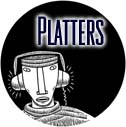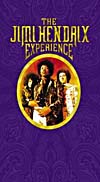
Comment
on this story
Sound Bites
Black Eyed Peas
Bridging the Gap (Interscope)
Spiritual descendants of the Native Tongues school of hip-hop, the California trio keeps the old school faith on their thoroughly likable second release. Guests range from forefathers (De La Soul) to fellow travelers (Mos Def, Macy Gray), but this is solidly the Peas' show, largely self-produced and infused with a loose West Coast dance floor vibe. "Weekends" is an old-time party jam of the first order, "Cali to New York" revisits De La's Daisy-era sound with a dose of G-funk, and the title track is an everybody-get-together quiet storm (complete with classical guitar). Warm and fuzzy as often as it is lean and funky, and clever to boot (see "Rap Song").
Kelly Willis
One More Time/The MCA Recordings (MCA)
OK, so it's an attempt by Willis' old label to cash in on her 1999 semi-breakthrough What I Deserve. It's also a chance to hear choice cuts from her three Nashville releases without trudging through their studio-slick low points. What you get is a nice crop of songs by a great selection of songwriters (Kostas, Jim Lauderdale, Paul Kelly, Marshall Crenshaw), all of them wrapped in Willis' honey-soaked twang. As a whole, it's less confident or personal than What I Deserve, but disarming nonetheless. The sound of a woman looking for her voice.
Indigo Girls
Retrospective (Epic)
The liner notes are by Susan Faludi and include lines like, "[T]he Indigo Girls are releasing this retrospective into an uneasy future for women's and gay-and-lesbian rights." Yes, well. As standard bearers for assorted causes, the Girls make pretty fair music. But as musicians, they sound like standard bearers. The favorites are all here—"Closer to Fine," "Galileo," "Shame on You"—complete with their sometimes hummable hooks and always insufferable lyrics. The harmonies are what they've always been, earnest and overbearing. I don't doubt their good intentions, but in the post-riot-grrl era, this sounds about as confrontational as Al Gore clearing his throat.
Enon
Believo! (See Thru Broadcasting)
Their very rock 'n' roll opening set for Flaming Lips the other week sent me back to this year-old release with a new appreciation. (This may be heresy of some sort, but for my $17 that evening, they blew away the headliners—I could only take so much of the Lips' faux-ironic grandeur.) Enon is equal parts would-be R&B sex machine, dreamy post-rock, and knob-twiddly navel-gazing. Their real trick is harnessing all of that to good old-fashioned songs, with verses and choruses and everything. You get the feeling they actually want you to sing along. And dance, too.
—Jesse Fox Mayshark
|
 |

A box set investigates a legend
by Mike Gibson
Jimi Hendrix
The Jimi Hendrix Experience (Reprise)

To the casual classic rawk consumer, Jimi Hendrix's status as electric rock guitarist non pareil is more an unthinking mantra than a critical discernment, a truism accepted more on blind faith than any real received knowledge. That's because most FM rock stations, strapped by timorous market research and hidebound playlists, are loathe to play the music that truly showcases Jimi Hendrix, guitar player, gypsy blues necromancer and radical rock revisionist. Instead, we hear mostly tasteful, restrained readings from the three studio records released during his short life, songs like "Purple Haze" and "Little Wing" or perhaps the multi-tracked vocal gem "(Have You Ever Been To) Electric Ladyland."
And while these cuts are broadly representative of the man's considerable gifts—as a boundlessly inventive songwriter, as a studio shaman, as a lyricist of understated poesy and an instrumentalist with an uncanny sense of rhythm, texture and orchestration—they manifest only flashes of his brilliance as a soloist. For that, we must turn to Hendrix's live oeuvre, a gaggle of mostly posthumous releases such as Live at Fillmore East or Band of Gypsies or Live at Winterland.
And now we can also turn to The Jimi Hendrix Experience, a new four-disc set of live gems, unheard (or at least little-heard) studio musings and mostly well-chosen outtakes, a set that has as its greatest virtue the pairing of Hendrix, thoughtful recording artist, with Jimi Hendrix, performer and player extraordinaire.
It's difficult to render analysis of four discs, all of which exceed the 60-minute mark in length, in a handful of paragraphs. But the yin-yang template of performer vs. studio sculptor provides a pretty apt paradigm. On the live tip, TJHE does the estimable service of re-releasing, in lovingly remastered form, several live cuts first released (and since discontinued) only on vinyl. The famous Monterey set (the fabled festival show that saw an inspired Hendrix engulf his audience in singalong rapture and his guitar in flame) is well-represented, most notably by his reading of Dylan's "Like a Rolling Stone." Expanding on the framework of the original Dylan melody, JH melds the seemingly incompatible notions of guitar as both supporting element and voice unto itself, channeling his virtuosity through the outlets of rhythmic interpretation and lyrical embellishment rather than sheer single-note brilliance.
The truly wondrous live pleasures, however, are mostly salvaged from a long-deleted long-player entitled Hendrix in the West, an astounding compendium of stand-out cuts from concerts in sundry Western American cities. Hendrix's Berkeley Community Theatre take on "Johnny B. Goode" is a veritable explosion of corrosive blues genius, as the guitarist hyper-charges the Chuck Berry proto-rock standard with flash-fire solo bursts and howling over-bends.
A broodingly intense 13-minute recitation of "Red House" (from the San Diego Sports Arena) is equally transportive, considered by some critics the definitive version of this Hendrix blues original. And a rare live version of the radiant "Little Wing," with unspeakably lovely chordal ornament and a floating, transcendent cadenza, seems to deliver in full on the lush promise of the too-brief studio original.
Returning to the studio, TJHE unearths buried treasures like "Gloria" (released once before, on the now-unavailable Essential Hendrix collection), the Experience's raga-esque jam on the '60s garage-rock standard, the droning intensity of the lockstep groove disrupted only by flashes of Hendrix's abundant good humor ("....and her breath smells like her p_____," he chortles in passing). On a studio rendering of the "Star Spangled Banner," meanwhile, JH's conception of the electric guitar as an orchestral tool reaches a rapturous pinnacle, the virtuoso sonic manipulations of the famous Woodstock live version replaced by a breathy chorale of sweetly over-driven six-strings.
As is the case with most box collections, there are several missteps on TJHE; a live Stockholm version of "Sgt. Pepper's Lonely Heart's Club Band" strips away the Beatles' spirited harmonies, yet adds little in the way of heavy rock impact or power-trio embellishment. And the Berkeley cover of Carl Perkins's "Blue Suede Shoes" is flat, uninspiring, bogged down by Hendrix's pedestrian vocal. Perhaps the set would have had more visceral force had it been pruned to a succinct two- or three-disc collection, presenting the case for Hendrix's genius in a frenetic mixed onslaught of live highlights and studio epiphanies.
But that would dodge the true nature of the man's wizardry, the origin of his singular muse. For the entity that gave animative force to both Hendrix the musician and Hendrix the guitar player was his probing, boundlessly venturesome spirit, his willingness not only to wreak havoc with the conventions of music and sound and guitar playing, but to reimagine them entirely. And that's something that no other release in the ever-growing Hendrix catalog, neither the incendiary live sets nor the crafted studio masterworks, can manifest in such detail.

October 19, 2000 * Vol. 10, No. 42
© 2000 Metro Pulse
|